Everyday Mathematics 3rd Grade Answer Key Unit 2 Number Stories and Arrays
Everyday Mathematics Grade 3 Home Link 2.1 Answers
Fact Extensions
Family Note Today your child used basic facts to solve similar problems with larger numbers. These similar problems are known as fact extensions. For example, the basic fact 6 + 7 = 13 helps solve the fact extension 60 + 70 = 130 . Talk to your child about the patterns in each set of problems. Help your child think of more fact extensions to complete this Home Link.
Write the answer for each problem.
Question 1.
I know:  This helps me know:
This helps me know: 
Answer:
Explanation:
As we know 9 + 7 = 16
So we divide 19 into 1 and 9 like in the picture below

So 9 + 7 = 16
Now add 10 to 16 as we have 1 in tens place
16 + 10 = 26
So we get 19 + 7 = 26
As we know 9 + 7 = 16
So we divide 69 into 6 and 9 like in the picture below
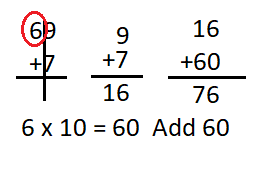
So 9 + 7 = 16
Now add 60 to 16 as we have 6 in tens place
16 + 60 = 76
So we get 69 + 7 = 76
As we know 9 + 7 = 16
So we divide 99 into 9 and 9 like in the picture below:
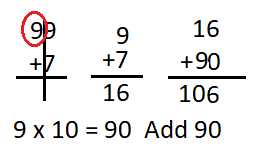
So 9 + 7 = 16
Now add 90 to 16 as we have 9 in tens place
16 + 90 = 106
So we get 99 + 7 = 106
Question 2.
I know: ![]() This helps me know:
This helps me know: 
Answer:

Explanation:
As we know 8 + 4 = 12
So we divide 18 into 1 and 8 like in the picture below
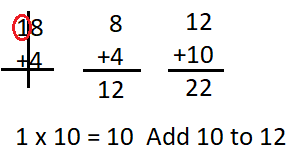
So 8 + 4 = 12
Now we add 10 to12 as we have 1 in tens place
10 + 12 = 22
So we get 18 + 4 = 22
As we know 8 + 4 = 12
So we divide 58 into 5 and 8 like in the picture belo
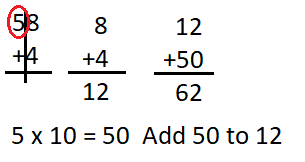
So 8 + 4 = 12
Now we add 50 to 12 as we have 5 in tens place
50 + 12 = 62
So we get 58 + 4 = 62
As we know 8 + 4 = 12
So we divide 278 into 27 and 8 like in the picture below:

As 8 + 4 = 12
Now we add 270 to 12 as we have 27 before 8
270 + 12 = 282
So we get 278 + 4 = 282
Question 3.
I know:  This helps me know:
This helps me know: 
Answer:

Explanation:
As we know 15 – 7 = 8
we divide the 3 and 5 as 3 is before 5 like in the picture below

As we know 15 – 7 = 8
Now to make 5 into 15 we have to remove 1 from 3
3 – 1 = 2
Then we have to add 1o 2 times
2 x 10 = 20
Then add 20 to 8
20 + 8 = 28
So we get 35 – 7 = 28
As we know 15 – 7 = 8
we divide 65 into 6 and 5 as 6 is before 5 like in the picture below
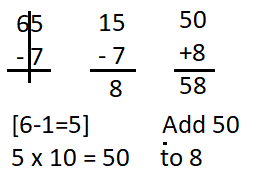
As we know 15 – 7 = 8
Now to make 5 into 15 we have to remove 1 from 6
6 – 1 = 5
Then we have to add 10, 5 times
5 x 10 = 50
Then add 50 to 8
50 + 8 = 58
So we get 65 – 7 = 58
As we know 15 – 7 = 8
we divide 105 into 10 and 5 as 10 is before 5 like in the picture below

As we know 15 – 7 = 8
Now to make 5 into 15 we have to remove 1 from 10
10 – 1 = 9
Then we have to add 10, 9 times
9 x 10 = 90
Then add 90 to 8
90 + 8 = 98
So we get 105 – 7 = 98
Question 4.
I know:  This helps me know:
This helps me know: 
Answer:

Explanation:
As we know 13 – 8 = 5
we divide 23 into 2 and 3 as 2 is before 3 like in the picture below
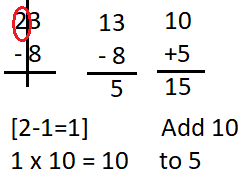
As we know 13 – 8 = 5
Now to make 3 into 13 we have to remove 1 from 2
2 – 1 = 1
Then we have to add 10, 1 times
1 x 10 = 10
Then add 10 to 5
10 + 5 = 15
So we get 23 – 8 = 15
As we know 13 – 8 = 5
we divide 123 into 12 and 3 as 12 is before 3 like in the picture below

As we know 13 – 8 = 5
Now to make 3 into 13 we have to remove 1 from 12
12 – 1 = 11
Then we have to add 10, 11 times
11 x 10 = 110
Then add 110 to 5
110 + 5 = 115
So we get 123 – 8 = 115
As we know 13 – 8 = 5
we divide 483 into 48 and 3 as 48 is before 3 like in the picture below

As we know 13 – 8 = 5
Now to make 3 into 13 we have to remove 1 from 48
48 – 1 = 47
Then we have to add 10, 47 times
47 x 10 = 470
Then add 470 to 5
470 + 5 = 475
So we get 483 – 8 = 15
Question 5.
I know: ![]() This helps me know:
This helps me know: 
Answer:

Explanation:
As we know 6 + 7 = 13
we will first add 6 and 7 like in the picture below:

So we get 6 + 7 = 13
In 60 we divide it into 6 an 10 as 6 x 10 = 60
So 6 + 7 = 13
Now multiply 13 with 10 as we have 1 zero in the units place
13 x 10 = 1300, So 600 + 700 = 1300
As we know 6 + 7 = 13
we will first add 6 and 7 like in the picture below:
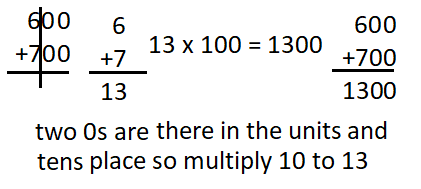
So we get 6 + 7 = 13
In 600 we divide it into 6 and 100 as 6 x 100 = 60
So 6 + 7 = 13
Now multiply 13 with 10 as we have 2 zero in the units place
13 x 100 = 1300
So 6000 + 7000 = 13000
As we know 6 + 7 = 13
we will first add 6 and 7 like in the picture below:
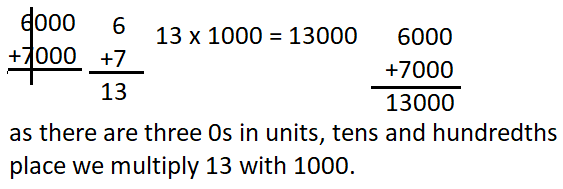
So we get 6 + 7 = 13
In 6000 we divide it into 6 an 10 as 6 x 1000 = 6000
So 6 + 7 = 13
Now multiply 13 with 1000 as we have 1 zero in the units place
13 x 1000 = 13000
So 6000 + 7000 = 1300
Make up another set of fact extensions.
Question 6.
I know:  This helps me know:
This helps me know: 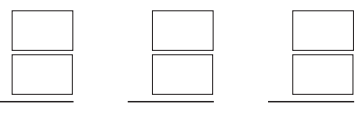
Answer:
I
Explanation:
By using fact extensions we can make our own facts and perform calculations like addition and subtracting
Everyday Math Grade 3 Home Link 2.2 Answer Key
Number Stories
Family Note Today your child reviewed parts-and-total, change, and comparison diagrams. These diagrams help organize the information in a number story. For more information, see Student Reference Book, page 76. Remind your child to write the unit with the answer. For example, the problem below asks about the number of cans, so the answer should include cans as the unit.
For the problem below:
- Write a number model. Use ? for the unknown.
- You may draw adiagram like the ones shown below or a picture to help.

- Solve the problem and write your answer.
- Explain how you know your answer makes sense.
Question 1.
The second- and third-grade classes collected 750 cans to recycle. The second graders collected 300 cans. How many cans did the third graders collect?
Number model: ____________
_____________ (unit)
Check: How do you know your answer makes sense?
Answer: 450 cans
Explanation:
Number model: 750 – 300 = 450 cans
300 cans + ______________ = 750 cans
The unknown has to be smaller then 750
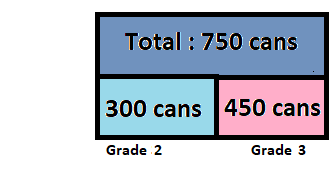
I know 3+4=7, so ..
3 (100)+4 (100)=7(100)+50 = 750
300 + 450 = 750
The answer makes my number model True
Everyday Mathematics Grade 3 Home Link 2.3 Answers
More Number Stories
Family Note Today your child solved more number stories using diagrams or pictures to help organize the information in the problems. Remind your child to write the unit with the answer. For example, the unit in the problem below is dollars, which can be represented by the dollar sign ($). Talk with your child about how he or she knows an answer makes sense.
For the number story below:
- Write a number model. Use a ? for the unknown.
- You may draw adiagram like those shown below or a picture to help.

- Solve and write your answer with the unit.
- Explain how you know your answer makes sense.
Question 1.
Jasmine had $35. She earned some money helping her neighbors. Now she has $52. How much money did she earn?
Number model: _________________________ (unit)
Check: How do you know your answer makes sense?
Answer:
Number model: $35 + $17 = $52
Explanation:
35 +____ = 52
52 – 35 = 17

The answer has to be less than 35 and 52 because she started with $35 and ended with $52.
The answer makes my number model True
Everyday Math Grade 3 Home Link 2.4 Answer Key
Multistep Number Stories, Part 1
Family Note Today your child practiced solving number stories with two or more steps. These solution strategies often combine at least two different operations (addition, subtraction, multiplication, or division). Children used drawings, words, and number models to help keep track of their thinking. Encourage your child to draw pictures or use objects to act out the stories below. Help your child make sense of each story by asking questions such as: What do you know from the story? What do you want to find out? What is your plan? What will you do first? Next? Does your answer make sense?
Solve each problem. Draw pictures or use words or number models to help keep track of your thinking. Remember to write the unit.
Question 1.
1 You have 12 red balloons and 13 blue balloons. Then 5 balloons pop. How many balloons do you have left?
_____________ (unit)
Answer:
No. of balloons left : 20
Explanation:
No. of red balloons : 12
No. of blue balloons : 13
Total number of balloons : 12 + 13 = 25
No. of balloons popped : 5
Number of balloons remaining : 25 – 5 = 20
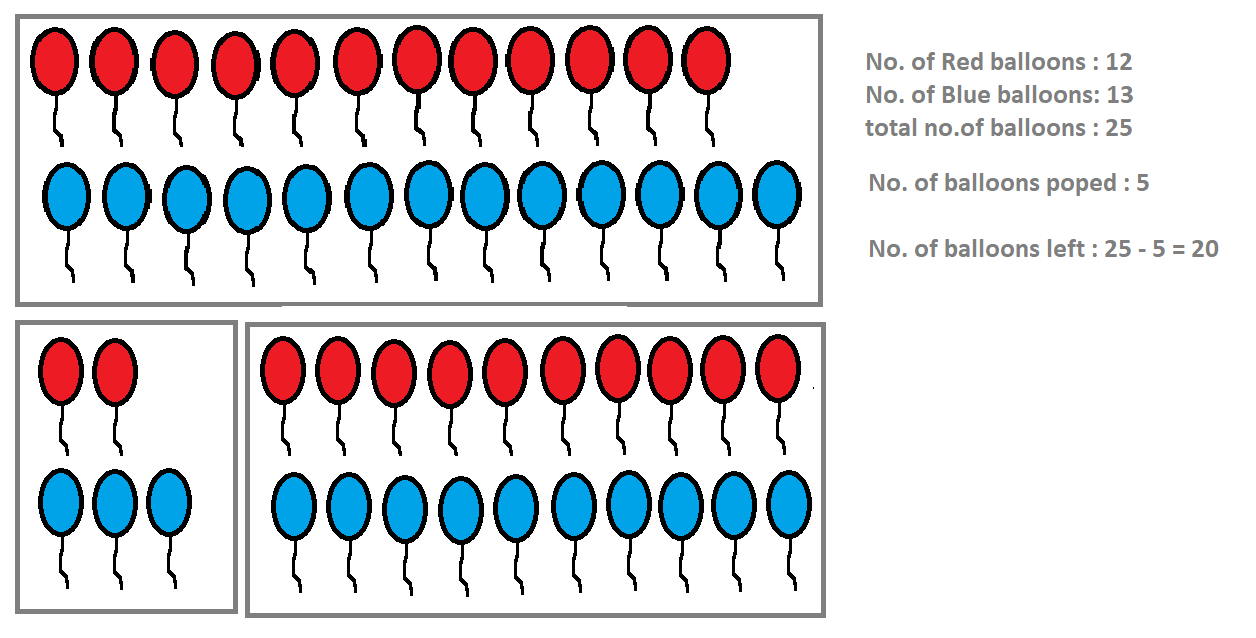
Question 2.
You have 3 bags of marbles with 6 marbles in each bag. Then you find 8 more marbles. How many marbles do you have now?
_____________ (unit)
Answer:
total no. of marbles : 26
Explanation :
No. of marbles in each bag : 6
No. of bags : 3
total no. of marbles : 3 x 6 = 18
No. of marbles found : 8
total no. of marbles : 18 + 8 = 26

Everyday Mathematics Grade 3 Home Link 2.5 Answers
Multistep Number Stories, Part 2
Family Note Today your child practiced solving additional number stories with two or more steps and writing number models for each step. Help your child make sense of the stories below by asking: What do you know from the story? What do you want to find out? What is your plan? What will you do first? Next? Have you answered the question? Does your answer make sense?
Solve each problem. Show your work with pictures, words, or numbers. Write number models to keep track of your thinking. Remember to write the unit.
Question 1.
Each basket in basketball is worth 2 points. Cathy makes 5 baskets and scores 6 more points with free throws. How many points did she score in all?
Number models: _____________
_____________ (unit)
Answer:
number models:
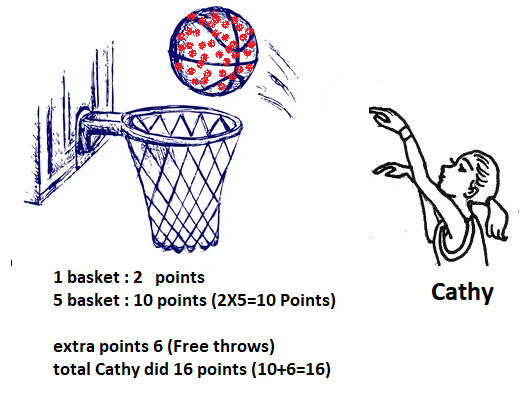
Total no. of points = 16 points
Explanation:
No. of points for each basket : 2 points
No. of baskets Cathy makes : 5 baskets
No. of points Cathy makes by free throws : 6 points
Total no. of points = No. of points Cathy makes by free throws + No. of points Cathy makes by baskets.
No. of points Cathy makes by baskets = No. of points for each basket x No. of baskets Cathy makes.
= 2 points x 5 points [2 x 5 = adding 2 5 times]
= 10 points [ 2 + 2 + 2 + 2 + 2 = 10 ]
Total no. of points = No. of points Cathy makes by free throws + No. of points Cathy makes by baskets.
= 6 points + 10 points
Total no. of points = 16 points
Question 2.
Elias reads 4 chapters. Each chapter has 10 pages. Then he reads 8 more pages. How many pages does Elias read in all?
Number models: _____________
_____________ (unit)
Answer:
Number models: 48 pages

Total no. of pages Elias read = 48 pages
Explanation:
No. of chapters read by Elias = 4 chapters
No. of pages in each chapter = 10 pages
No. of extra pages read by Elias = 8 pages
Total no. of pages read by Elias = No. of pages read by Elias in 4 chapters + No. of extra pages read by Elias
No. of pages read by Elias in 4 chapters = No. of chapters read by Elias x No. of pages in each chapter
= 4 x 10 pages [4 x 10 = 10 added 4 times]
= 40 pages [10 + 10 + 10 + 10 = 40]
Total no. of pages read by Elias = No. of pages read by Elias in 4 chapters + No. of extra pages read by Elias
= 40 pages + 8 pages
= 48 pages
Everyday Math Grade 3 Home Link 2.6 Answer Key
Equal-Groups Number Stories
Family Note Today your child practiced using efficient ways to solve equal-groups number stories, such as using repeated addition, skip counting, or using facts he or she knows. Children also talked about what multiplying by 0 or 1 means. Encourage your child to use the number stories to explain why multiplying by 0 equals 0 and multiplying by 1 equals the number in one group.
Solve. Show your thinking using drawings, words, or number models.
Question 1.
A pack of Brilliant Color Markers contains 5 markers. Each pack costs $2.
If you buy 6 packs, how many markers will you have?
_____________ (unit)
Answer:
Total no. of markers : 30 markers
Explanation:
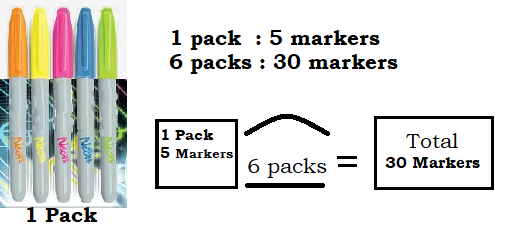
Total no. of markers : 30 markers
Explanation:
No. of makers each pack has : 5 markers
Each pack costs : $2.
No. of packs bought : 6 packs
Total no. of markers : No. of packs bought x No. of makers each pack has
: 6 x 5 markers [6 x 5 = 6 added 5 times]
: 30 markers [6 + 6 + 6 + 6 + 6 = 30 ]
Total no. of markers : 30 markers
Question 2.
How much do 0 packs of Brilliant Color Markers cost?
_____________ (unit)
Explain your answer.
Answer:
Cost of 0 packs : $0
Explanation:
Each pack costs : $2.
No. of packs bought : 0 packs
Cost of 0 packs : No. of packs bought x Cost of each pack
: 0 x $2 [2 x 0 = 0 added 2 times]
: $0 [0 + 0 = 0]
Cost of 0 packs : $0
Question 3.
Make up a number story to match the number sentence below:
1 × 5 = 5
Answer:
A toy box costs $5 . If you buy 1 toy box , How much do you need to pay to the shopkeeper?
Everyday Mathematics Grade 3 Home Link 2.7 Answers
Representing Situations with Arrays
Family Note Today your child practiced drawing arrays to represent number stories. Your child also played Array Bingo to practice multiplication facts with arrays and equal groups.
Question 1.
There are 12 trombone players in a parade. Show at least 3 different ways they can be arranged into arrays. Show your work on the dot grids below. Write a number model for each array.

Answer:

Explanation:
1) array : 1 x 12 = 12
2) array : 2 x 6 = 12
3) array : 3 x 4 = 12
4) array : 4 x 3 = 12
Question 2.
Can you make an array with 5 rows for the 12 players? Explain.
Answer:
No
Explanation:
As an array of 5 x 2 will be 10
An array of 5 x 3 will be 15
we will not get an array for 5 rows
So when I make an array of 5 rows I will have 2 less.
Everyday Math Grade 3 Home Link 2.8 Answer Key
Creating Mathematical Representations
Family Note Your child is learning how to create mathematical representations, such as drawings, words, and number models, to help solve division problems. In this lesson we solved division problems with and without remainders. Talk to your child about the representations he or she can use to help solve Problems 1 and 2 and how to handle the remainder in Problem 2.
Solve. Show your thinking in a drawing or number model.
Question 1.
Amit won a pack of 24 stickers in a school contest. He put the stickers into 3 equal piles, one for himself and one each for his friends, Danny and Sue. How many stickers will each get?
Each gets __8_____ stickers.
Answer:
Total 24 Stickers
Explanation:
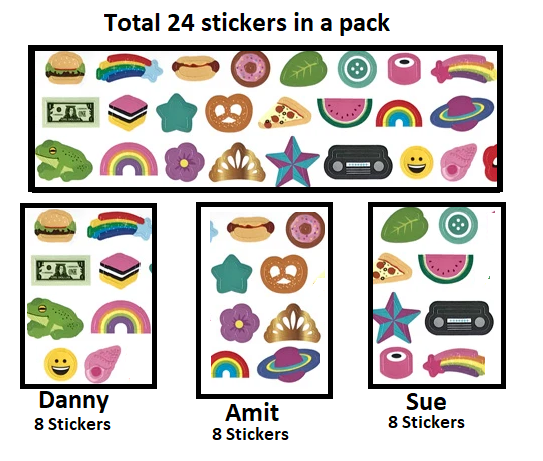
Amit put stickers into 3 equal piles of each 8 stickers
8 + 8 + 8 = 24 stickers
Danny :8 Stickers
Sue :8 Stickers
Amit : 8 stickers (for him self)
Question 2.
Parents are organizing a field trip to the zoo for Amit’s class. They want to take the 23 children in their cars. If each car can carry 5 children, how many cars are needed?
__________ cars are needed for the field trip.
Answer:
5 cars are needed for the field trip.
Explanation:
No. of children in Amit’s class : 23
Parents : 2 [Mom and Dad]
Total no. of persons going to the Zoo : No. of children in Amit’s class + Parents
: 23 + 2 = 5
1 car can carry : 5 persons
No of cars needed : Total no. of persons going to the Zoo ÷ No. of persons 1 car can carry
: 25 ÷ 5
: 5
So 5 cars are needed for the field trip.
Everyday Mathematics Grade 3 Home Link 2.9 Answers
Modeling with Division
Family Note Today your child solved equal-sharing number stories. Sometimes when we share or divide a quantity, there are parts left over, or remainders. Your child practiced recording division number models with remainders. For example, 10 marbles shared 3 ways could be recorded as 10 ÷ 3 → 3 R 1, which can be read as “10 divided by 3 gives us 3 with a remainder of 1.” Help your child solve the problems below. You may want to use counters, such as coins or dry pasta, to act out each story.
Draw pictures to show someone at home how you can use division to solve number stories. Write a number model for each story.
Question 1.
Jamal gives 24 marbles to 4 friends. Each friend gets the same number of marbles. How many marbles does each friend get?
____________ (unit)
How many marbles are left over? ____________ (unit)
Number model: ____________
Answer:
Each friend gets 6 marbles
Marbles left : 0 marbles
Number model :

Explanation :
No. of marbles Jamal has : 24 marbles
No. of friends Jamal has : 4
To divide 24 marbles equally among Jamal’s friends
We have to : No. of marbles Jamal has ÷ No. of friends Jamal has
: 24 ÷ 4
: 6 marbles
Each friend gets 6 marbles
Since there is no remainder left
No. of marbles left : 0 marbles
Question 2.
Eliza has 29 flowers to arrange in 5 vases. She puts the same number of flowers in each vase. How many flowers does she put in each vase? ____________ (unit)
How many flowers are left over? ____________ (unit)
Number model: ____________
Answer:
Eliza puts 5 flowers in each vase
There are 4 flowers left over
Number model:
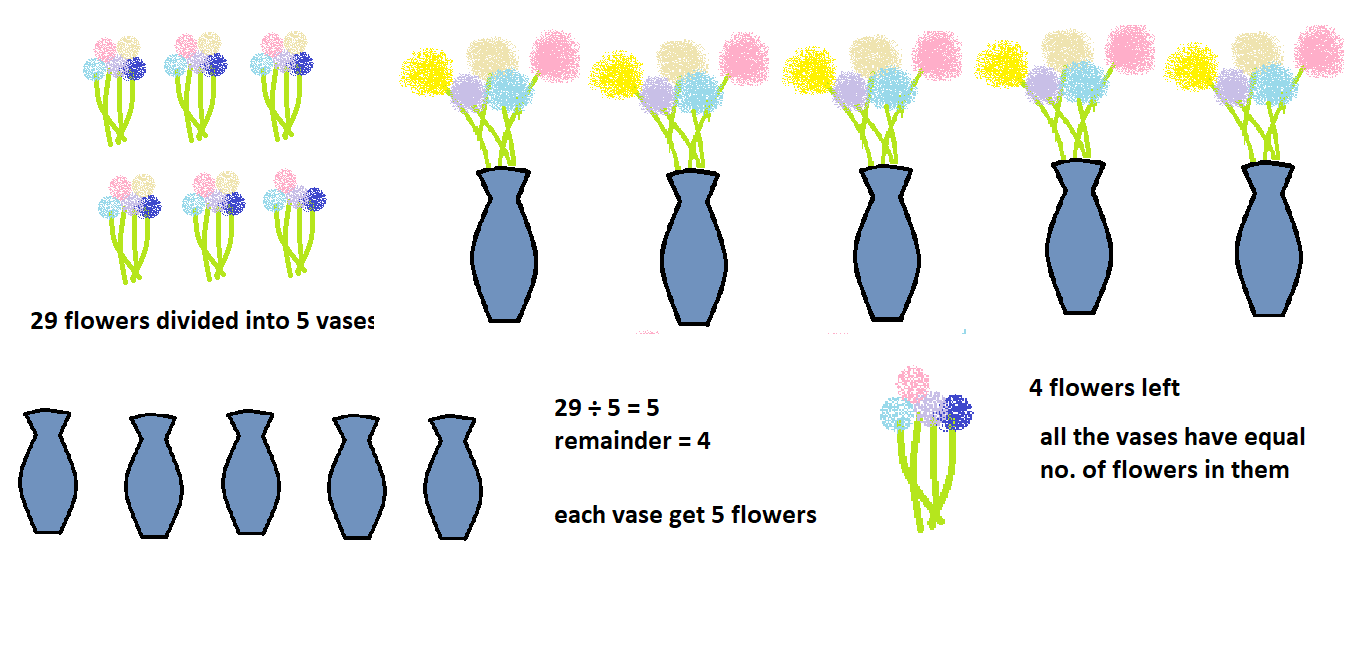
Explanation:
No. of flowers Eliza has : 29 flowers
No. of flowers Eliza : 5 vases
To find out how many flowers each vase has we need to :
No. of flowers Eliza ÷ No. of flowers Eliza
29 ÷ 5 = 5
remainder : 4
So Eliza puts 5 flowers in each vase
Since there are 4 flowers left over
There are 4 flowers left over
Question 3.
A sheet of stamps has 46 stamps. A complete row has 10 stamps. How many complete rows are there? ____________ (unit)
How many stamps are left over? ____________ (unit)
Number model: ____________
Answer:
No. of complete rows of stamps : 4 rows
No. of stamps left : 6 stamps
Number model :
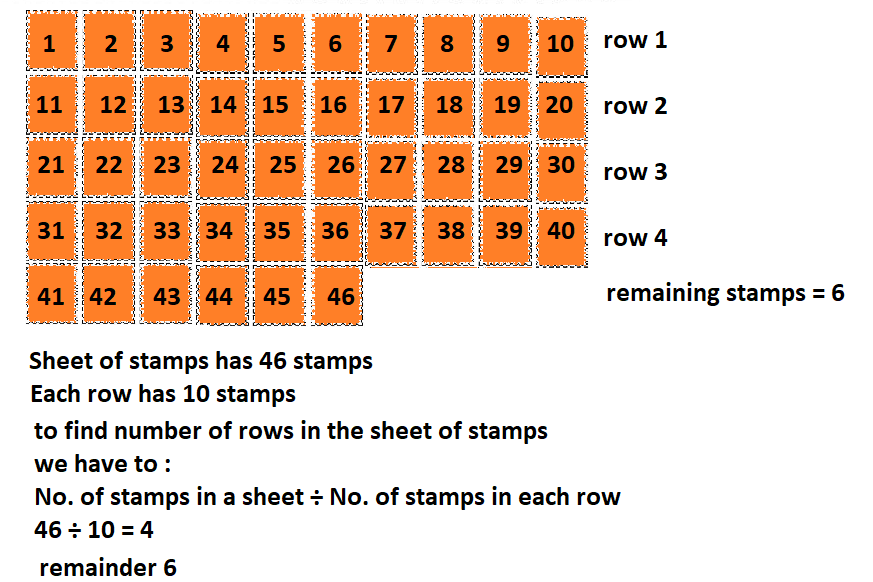
Explanation:
No. of stamps in a sheet : 46 stamps
No. of stamps in each row : 10
No. of rows : No. of stamps in a sheet ÷ No. of stamps in each row
: 46 ÷ 10
: 4
reminder : 6
So No. of complete rows of stamps : 4 rows
As remainder is 6
No. of stamps left : 6 stamps
Everyday Math Grade 3 Home Link 2.10 Answer Key
Division with Arrays
Family Note Today your child practiced using arrays to model problems and show division with and without remainders. Children also learned a new game called Division Arrays.
Use arrays to represent each division problem. If there is a remainder, show it in the Leftovers column.
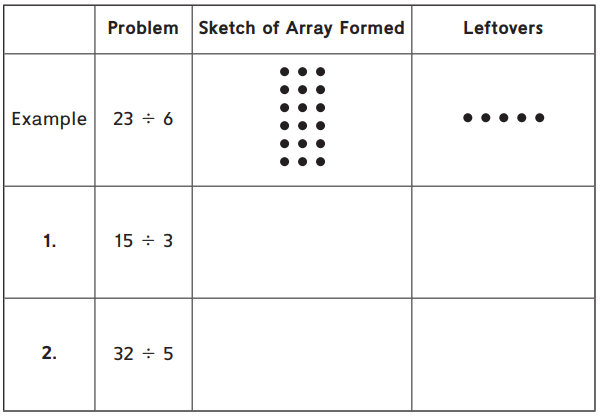
Answer:

Explanation:
1) 15 ÷ 3 = 5
As 15 ÷ 3 means dividing 15 into 3 parts
So 15 ÷ 3 = 5
we have drawn a 3 x 5 array
as there is no remainder we have not drawn anything in the leftovers column
2) 32 ÷ 5 = 6
As 32 ÷ 5 means dividing 32 into 5 parts
S o 32 ÷ 5 = 6
we have draw a 6 x 5 array
as there is no remainder we have not drawn anything in the leftovers column.
Question 3.
List household items you could share with your family members that might have leftovers, for example, spoons, plates, and cups.
Answer:
A pack of markers
pillows in the house
Practice
Question 4.
5 × 5 = _______
Answer:
5 x 5 = 25
Explanation:
5 x 5 = adding 5, 5 times
5 + 5 + 5 + 5 + 5 = 25
Question 5.
40 = 5 × _______
Answer:
40 = 5 x 8
Explanation:
by taking 5 to the left side of the equation we get:
40 ÷ 5 = ___
so now 40 ÷ 5 = 8 [dividing 40 into 5 parts]
Question 6.
20 ÷ 5 = _______
Answer:
20 ÷ 5 = 4
Explanation:
20 ÷ 5 = __
dividing 20 with 5 we will get 4
so,
20 ÷ 5 = 4
Question 7.
45 ÷ _______ = 5
Answer:
45 ÷ 9 = 5
Explanation:
45 ÷ _______ = 5
if we take 5 to the left side of the equation we will get:
45 ÷ 5 = ___
dividing 45 with 5 we get 9
so,
45 ÷ 9 = 5
Everyday Mathematics Grade 3 Home Link 2.11 Answers
Frames and Arrows
Family Note Today your child reviewed Frames and Arrows, which provide opportunities to look for addition, subtraction, multiplication, or division patterns. Your child used the patterns to fill in missing rules and blank frames.
Show someone at home how to complete these Frames-and-Arrows diagrams.
Question 1.

Answer:

Explanation:
Using +3 rule we get
12 + 3 = 15
15 + 3 = 18
18 + 3 = 21
21 + 3 = 24
24 + 3 = 27
Question 2.

Answer:

Explanation:
Using – 100 rule we get
1000 – 100 = 900
900 – 100 = 800
800 – 100 = 700
700 – 100 = 600
600 – 100 = 500
Question 3.

Answer:

Explanation:
Rule = 6
We can find the rule by :
48 – 42 = 6
24 + 6 = 30
30 + 6 = 36
36 + 6 = 42
42 + 6 = 48
48 + 6 = 54
Practice
Solve.
Question 4.
_______ = 6 × 5
Answer:
30 = 5 x 6
Explanation:
5 x 6 means adding 6 five times
6 + 6 + 6 + 6 + 6 = 30
So we get 6 x 5 = 30
Question 5.
_______ = 6 × 10
Answer:
6 x 10 = 60
Explanation:
6 x 10 means adding 10 6 times
10 + 10 +10 + 10 + 10 + 10 = 60
Question 6.
5 × _______ = 20
Answer:
5 x 4 = 20
Explanation:
5 x __ = 20
if we take 5 to the right side of the equation
we get: 20 ÷ 5 = __
20 ÷ 5 = 4 [dividing 20 with 5 we get 4]
Question 7.
10 × _______ = 40
Answer:
10 x 4 = 40
Explanation:
10 x ___ = 40
if we take 10 to the right side of the equation
we get: 40 ÷ 10 = __
40 ÷ 10 = 4 [dividing 40 with 10 we get 4]
Everyday Math Grade 3 Home Link 2.12 Answer Key
Liquid Volume and Area
Family Note Today your child explored the ideas of liquid volume and area. Before your child is exposed to formal work with these measures (such as equivalent units of liquid volume or formulas for finding area), it is important to have concrete, exploratory experiences with these measures.
In Problem 1, help your child see that although the glasses may have different dimensions, they can still hold about the same amount of water. In Problem 2, the number of squares that your child counts is the area measurement in square centimeters.
Question 1.
Pour some water into a cup at home. Pour all the water from the cup into a bowl. Does the volume or amount of liquid change when you pour it from one container to the other? Explain your thinking.
Answer:
No the volume of the water does not change when I pour it from one container to the other.
Explanation:
Question 2.
Count squares to find the area of each figure.

Answer:
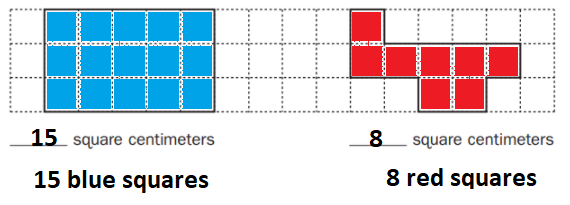
Explanation:
first count the no. of squares in the given first shape
then write the number of squares in the blank
in figure 1:
No. of squares : 15
in figure 2:
No. of squares : 8
Practice
Question 3.
6 × 2 = _______
Answer:
6 x 2 = 12
Explanation:
by multiplying 6 with 2 we get
6 x 2 = [adding 6 two times]
6 + 6 = 12
So, 6 x 2 = 12
Question 4.
14 = 2 × _______
Answer:
14 = 2 x 7
Explanation:
14 = 2 x __
by taking 2 to the right side of the equation, We get
14 ÷ 2 = 7 [dividing 14 with 2 we get 7]
Question 5.
_______ = 18 ÷ 2
Answer:
9 = 18 ÷ 2
Explanation:
18 ÷ 2 = 9 [by dividing 18 with 2 we get 9]
Question 6.
16 ÷ _______ = 8
Answer:
16 ÷ 2 = 8
Explanation:
16 ÷ ___ = 8
by taking 16 to the right side of the equation we get:
16 ÷ 8 = 2 [dividing 16 with 8 we get 2]